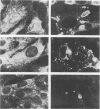Abstract
Exposure of both mammalian and reptilian cells in tissue culture to different strains of fixed rabies virus resulted in a carrier type of infection. No cytopathic effect was observed in either type of culture; infected cultures could be maintained by cell transfer for unlimited numbers of passages. A consistent pattern of cyclically rising and falling levels of viral infection was observed by fluorescent-antibody staining techniques and by titration of released infectious virus. Resistance to super-infection by vesicular stomatis virus and the production of an interferon-like substance by infected cells indicated that the maintenance of a carrier type of infection may be interferon-mediated. The degree of susceptibility of rabies-infected cells to immunolysis by antirabies antibody in the presence of complement was found to be correlated with the amount of virus maturation occurring by budding through the cell membrane and not with the presence of immunofluorescent antigen in the cytoplasm of infected cells.
Full text
PDF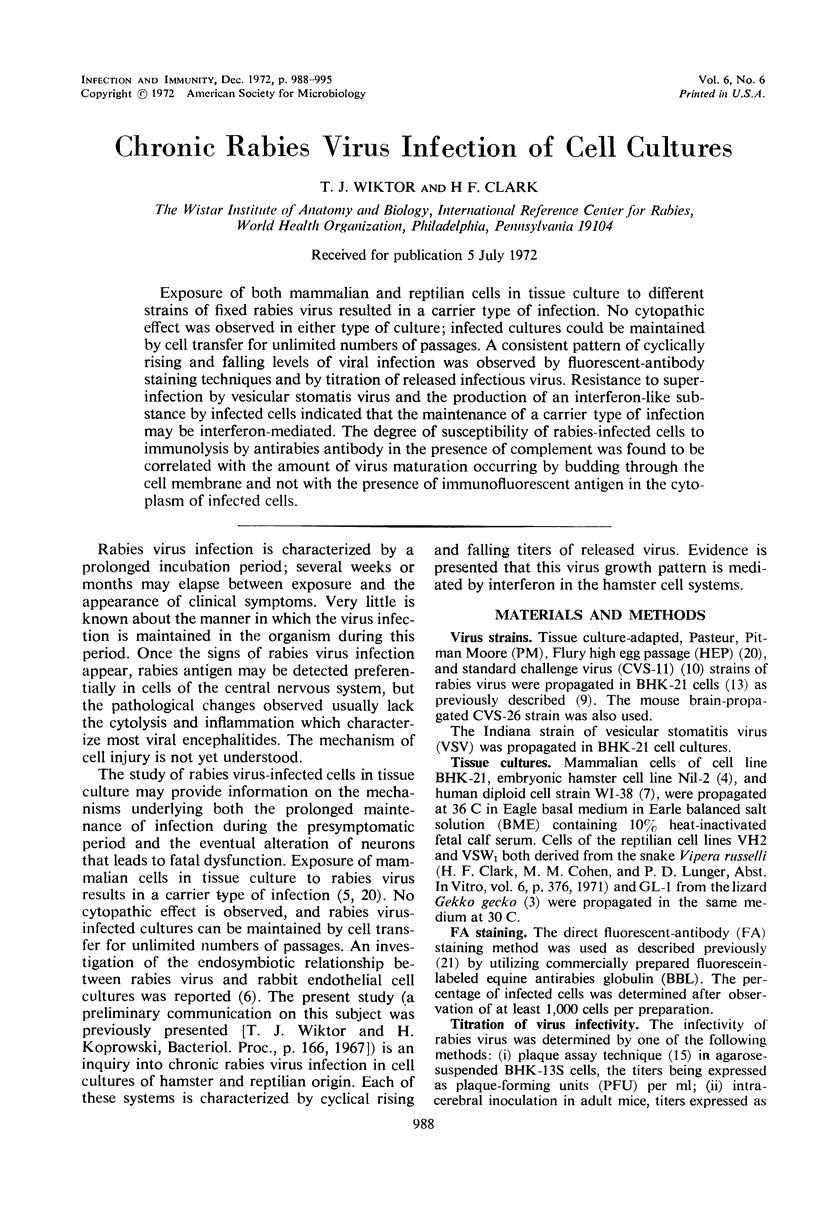
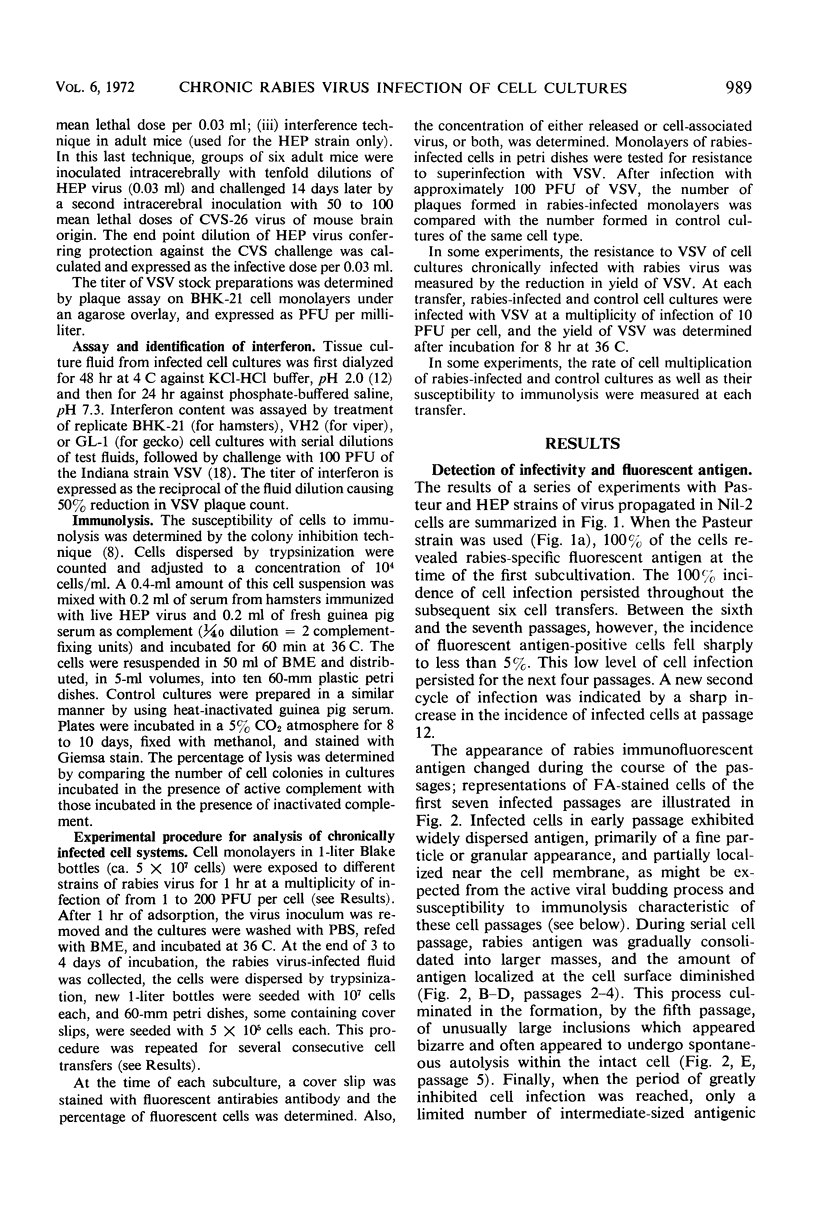
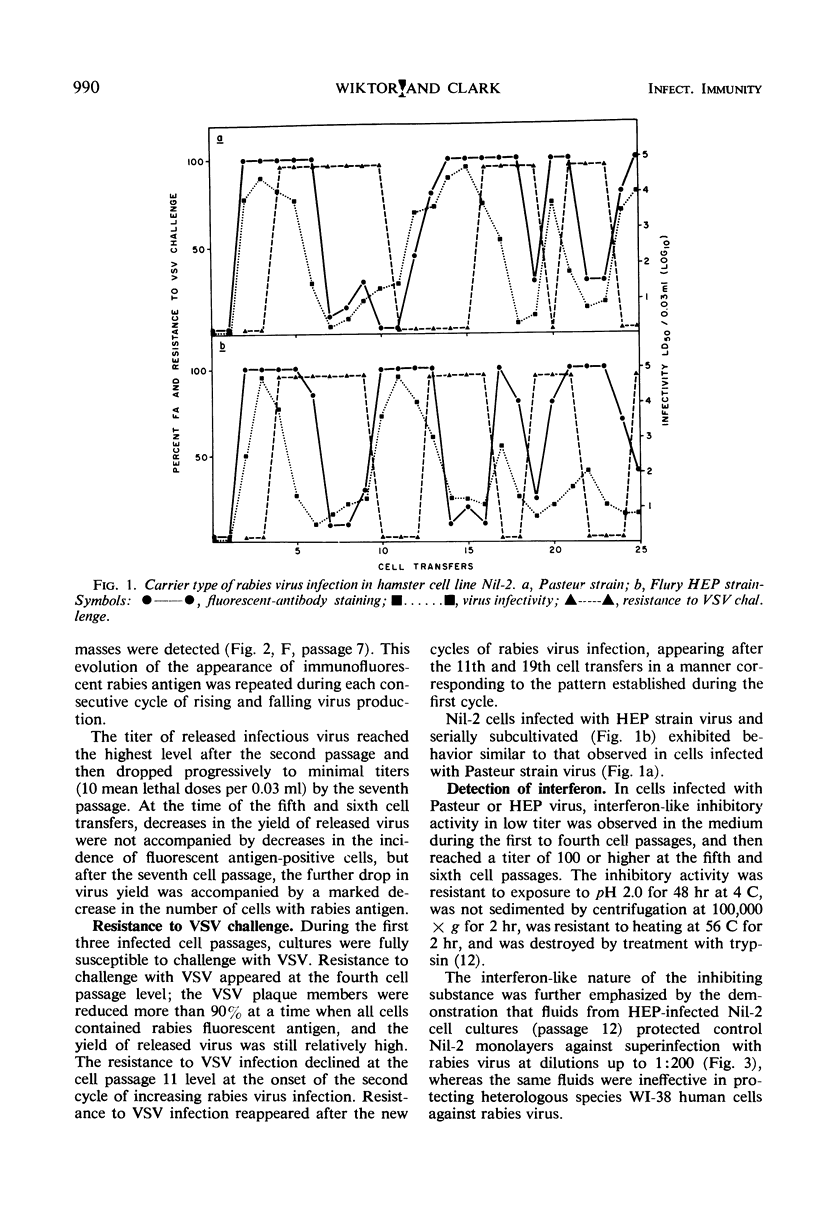

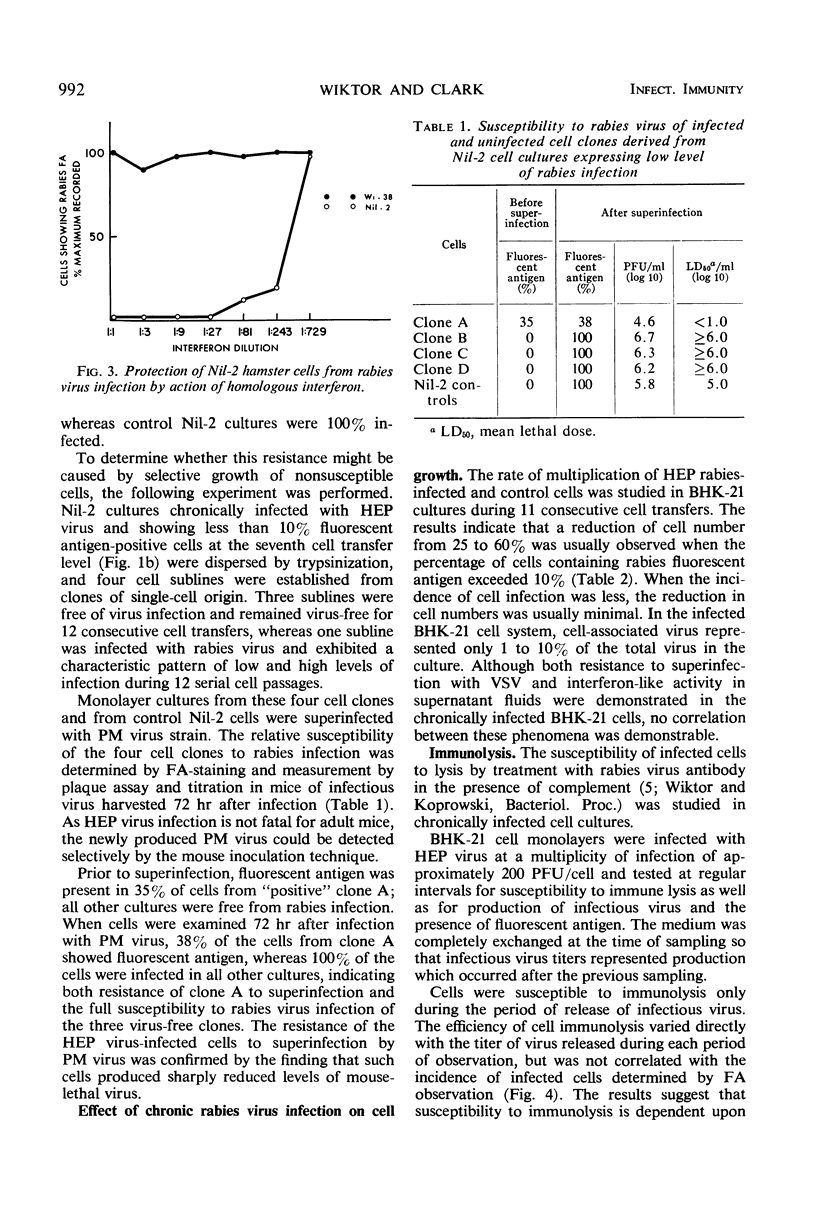
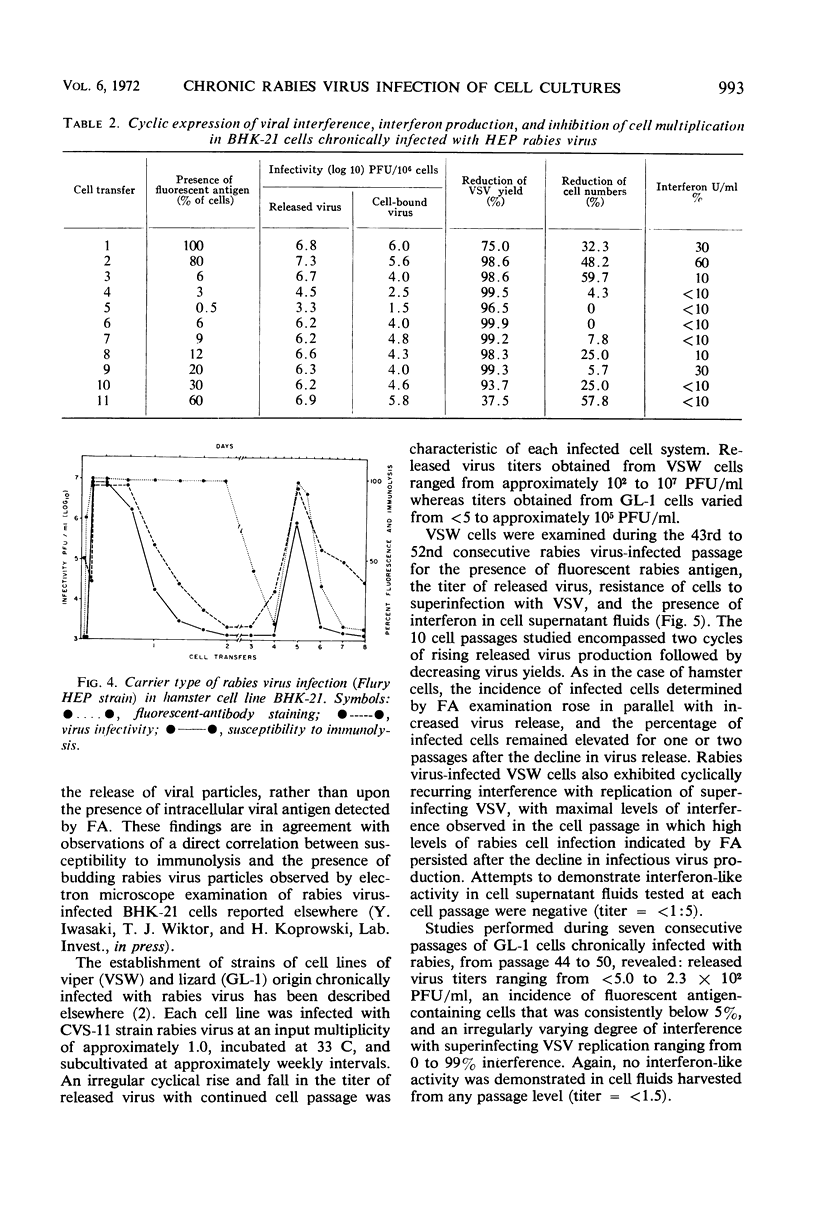
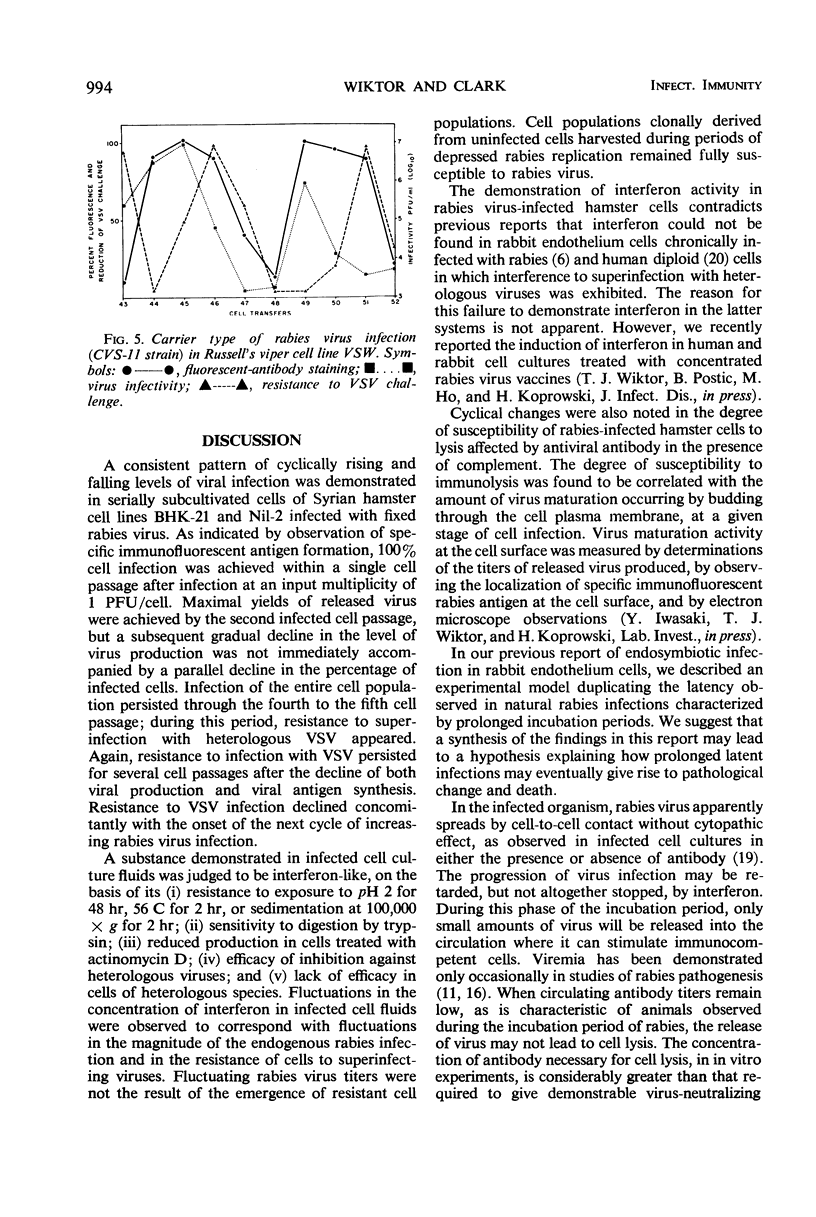

Images in this article
Selected References
These references are in PubMed. This may not be the complete list of references from this article.
- Baer G. M., Cleary W. F. A model in mice for the pathogenesis and treatment of rabies. J Infect Dis. 1972 May;125(5):520–527. doi: 10.1093/infdis/125.5.520. [DOI] [PubMed] [Google Scholar]
- Clark H. F., Cohen M. M., Karzon D. T. Characterization of reptilian cell lines established at incubation temperatures of 23 to 36 degrees. Proc Soc Exp Biol Med. 1970 Mar;133(3):1039–1047. doi: 10.3181/00379727-133-34622. [DOI] [PubMed] [Google Scholar]
- Clark H. F., Kritchevsky D. Growth and attenuation of rabies virus in cell cultures of reptilian origin. Proc Soc Exp Biol Med. 1972 Apr;139(4):1317–1325. doi: 10.3181/00379727-139-36354. [DOI] [PubMed] [Google Scholar]
- Diamond L. Two spontaneously transformed cell lines derived from the same hamster embryo culture. Int J Cancer. 1967 Mar 15;2(2):143–152. doi: 10.1002/ijc.2910020209. [DOI] [PubMed] [Google Scholar]
- FERNANDES M. V., WIKTOR T. J., KOPROWSKI H. ENDOSYMBIOTIC RELATIONSHIP BETWEEN ANIMAL VIRUSES AND HOST CELLS. A STUDY OF RABIES VIRUS IN TISSUE CULTURE. J Exp Med. 1964 Dec 1;120:1099–1116. doi: 10.1084/jem.120.6.1099. [DOI] [PMC free article] [PubMed] [Google Scholar]
- FERNANDES M. V., WIKTOR T. J., KOPROWSKI H. MECHANISM OF THE CYTOPATHIC EFFECT OF RABIES VIRUS IN TISSUE CULTURE. Virology. 1963 Sep;21:128–131. doi: 10.1016/0042-6822(63)90312-x. [DOI] [PubMed] [Google Scholar]
- HAYFLICK L., MOORHEAD P. S. The serial cultivation of human diploid cell strains. Exp Cell Res. 1961 Dec;25:585–621. doi: 10.1016/0014-4827(61)90192-6. [DOI] [PubMed] [Google Scholar]
- Hellström I., Sjögren H. O. Demonstration of H-2 isoantigens and polyoma specific tumor antigens by measuring colony formation in vitro. Exp Cell Res. 1965 Oct;40(1):212–215. doi: 10.1016/0014-4827(65)90320-4. [DOI] [PubMed] [Google Scholar]
- KISSLING R. E. Growth of rabies virus in non-nervous tissue culture. Proc Soc Exp Biol Med. 1958 Jun;98(2):223–225. doi: 10.3181/00379727-98-23997. [DOI] [PubMed] [Google Scholar]
- Kaplan M. M., Wiktor T. J., Maes R. F., Campbell J. B., Koprowski H. Effect of polyions on the infectivity of rabies virus in tissue culture: construction of a single-cycle growth curve. J Virol. 1967 Feb;1(1):145–151. doi: 10.1128/jvi.1.1.145-151.1967. [DOI] [PMC free article] [PubMed] [Google Scholar]
- MACPHERSON I., STOKER M. Polyoma transformation of hamster cell clones--an investigation of genetic factors affecting cell competence. Virology. 1962 Feb;16:147–151. doi: 10.1016/0042-6822(62)90290-8. [DOI] [PubMed] [Google Scholar]
- Sedwick W. D., Wiktor T. J. Reproducible plaquing system for rabies, lymphocytic choriomeningitis,k and other ribonucleic acid viruses in BHK-21-13S agarose suspensions. J Virol. 1967 Dec;1(6):1224–1226. doi: 10.1128/jvi.1.6.1224-1226.1967. [DOI] [PMC free article] [PubMed] [Google Scholar]
- Sikes R. K., Cleary W. F., Koprowski H., Wiktor T. J., Kaplan M. M. Effective protection of monkeys against death from street virus by post-exposure administration of tissue-culture rabies vaccine. Bull World Health Organ. 1971;45(1):1–11. [PMC free article] [PubMed] [Google Scholar]
- WAGNER R. R. Biological studies of interferon. I. Suppression of cellular infection with eastern equine encephalomyelitis virus. Virology. 1961 Mar;13:323–337. doi: 10.1016/0042-6822(61)90152-0. [DOI] [PubMed] [Google Scholar]
- WIKTOR T. J., FERNANDES M. V., KOPROWSKI H. CULTIVATION OF RABIES VIRUS IN HUMAN DIPLOID CELL STRAIN WI-38. J Immunol. 1964 Sep;93:353–366. [PubMed] [Google Scholar]
- Wiktor T. J., Koprowski H. Propagation of rabies virus in tissue culture. Monogr Ser World Health Organ. 1966;23:173–178. [PubMed] [Google Scholar]
- Wiktor T. J., Kuwert E., Koprowski H. Immune lysis of rabies virus-infected cells. J Immunol. 1968 Dec;101(6):1271–1282. [PubMed] [Google Scholar]



